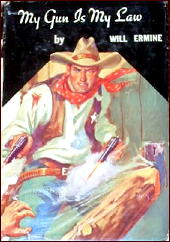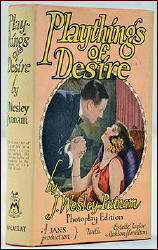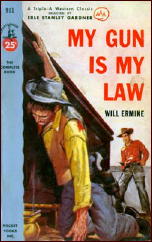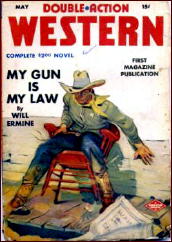Tue 8 Jul 2014
Archived Western Review: WILL ERMINE – My Gun Is My Law.
Posted by Steve under Authors , Reviews , Western Fiction[5] Comments
WILL ERMINE – My Gun Is My Law. Pocket 911; paperback reprint; 1st printing, November 1952. Hardcover editions: William Morrow, October 1942; Grosset & Dunlap, 1946; Jefferson House “Triple-A Western Classic,†March 1950. Also published in Double-Action Western, May 1943 (perhaps abridged). Introduction to Jefferson House and Pocket editions by Erle Stanley Gardner.
I didn’t know this before doing some research on the subject, but as it so happens, Will Ermine is one of several pen names that Harry Sinclair Drago (1888-1979) used to write westerns, including his own.
Another of Drago’s assumed aliases is Bliss Lomax, which I knew, and a quick dive into the Internet produced some other information. Not all of his books were westerns, for example. One of his books, Playthings of Desire (Macaulay, 1924), as by J. Wesley Putnam, is about the illicit affairs of a Broadway actress, and was the basis for a silent film of the same name. Starring were Estelle Taylor, Mahlon Hamilton, Dagmar Godowsky and Mary Thurman. When the movie was produced again in 1933, the featured players were Linda Watkins, James Kirkwood, Reed Howes and Josephine Dunn.
None of these people were previously known to me. Perhaps they were household names at the time. Fame is sometimes a fleeting thing.
Getting back to western fiction, though, here’s an interesting look into the effort that Drago did to make his western fiction as authentic as possible. The paragraph below is taken from Richard Patterson’s introduction to a book that Drago did on the history of the west, Outlaws on Horseback: The History of the Organized Bands of Bank and Train Robbers Who Terrorized the Prairie Towns of Missouri, Kansas, Indian Territory, and Oklahoma for Half a Century, reprinted by the University of Nebraska Press in 1998:
The original edition of this work was published by Bramall House in 1964. For another view of Drago’s attitude toward writing, I can’t tell you where the following quote first appeared, one I found on the Internet, but here it is anyway:
When asked how he wrote over 100 books: “Four pages a day, that’s how you write 100 books. That’s how you write books.â€
My Gun Is My Law is a title that really doesn’t have anything much to do with the book of the same name. As Erle Stanley Gardner points out in his introduction, the central theme of this western novel is the family feud. Two of the men who originally settled the hundred-mile length of Spirit Valley, Jube (Stonewall) Gordon and Rusty Cameron soon began fighting each other, their hatred beginning a quarrel between the two that lasted for forty years, claiming the lives of most of both men’s sons, not to mention scores of men who worked for either side.
For most of that time the feud was fought according to rules. From page 3:
As you see, this is very much in the vein of the traditional western, which also means, of course, there is also a romance involved, no matter how serious and how deadly the feud between the two families may be. Here’s a rather long quote from page 10, and you’re probably way ahead of me on this. At a local dance, with both sides in attendance, and on their “best†behavior toward each other:
“Miss Gordon,†he said so softly that many could not hear, “might I have the honor of this dance with you?â€
Men and women held their breath, stunned by his request and certain that Necia would say no and put him in his place. They were in no doubt as to what would follow. Guns would talk here tonight. They knew they should be thinking of their own safety, getting out of the way. For the moment, however, they were helpless to do anything about it. A spell had been put on them, and they could only stare at Cape and Necia.
They saw him regard him with a curious interest, the color coming and going in her cheeks. She seemed calm enough, with Cape’s preposterous advance ringing in her ears and the eyes of everyone in the room on her. They knew she was alive to the significance of this moment and its inevitable consequences, and they told themselves that if she was slow to answer it was only because she wanted what she said to be adequate and final.
But, to their surprise, something flowed into her dark eyes that was warm and friendly. A smile parted her lips.
“I’d be most pleased to dance with you, Mr. Cameron,†she said simply and with a trace of her father’s familiar drawl.
With well over 150 pages of small print to go in the paperback edition, this is of course only the first step toward a truce, and not all of the characters survive to the end. As a matter of fact, the local doctor, a young fellow somewhat acquainted with the new science of ballistics, does a fine job of detective work, finding a killer in a shooting where no one was even suspected. Microscopes do come in handy! – even in a land where guns make up 90% of the law.
For a fellow that started early in the pulps (circa 1922), Drago/Ermine has a flair for the right word in the right place, albeit with a certain stiffness in the telling every so often. From this (admittedly) small sample of size one, I’d definitely say he’s worth seeking out and hunting down to read more of his work.
2005 (slightly shortened and revised).




July 8th, 2014 at 6:46 pm
I remember Drago more for his well researched non fiction about the west under his own name, though I have read a few Ermine’s and Lomax titles. But once he was one of the names to be reckoned with like Short, Raine, Macdonald, Haycox, Tuttle, and a few more.
Oddly though I don’t think I ever read anything fictional of his under the Drago name.
July 8th, 2014 at 7:55 pm
David,
Buckskin Empire by Drago. Quite entertaining. Filmed under the title, Buckskin Frontier with Richard Dix, Jane Wyatt (extremely appealing) Victor Jory and Albert Dekker used in an unusual manner. Fine score by Victor Young, and there are quite a few of those.
July 8th, 2014 at 8:02 pm
Barry
I had to hunt to find the movie on IMDb and found an error in the title as you gave it, so I corrected it. This is a film I hadn’t known about before, from 1943. I’ll have to check it out. Thanks for the tip!
July 8th, 2014 at 9:52 pm
Steve,
Sorry about the error. The film has plenty of charm and action, under whatever title.
July 11th, 2014 at 2:03 pm
Barry
Thanks, I think I have seen this one and missed the Drago connection, but it is as good as you say. After Cimarron Dix made a number of fine movies including Man of Conquest as Sam Houston and based, if not credited, on Paul I. Wellman’s Magnificent Destiny.